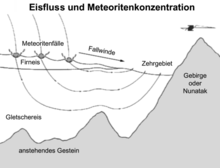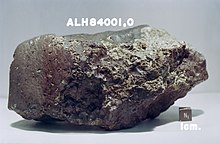History of astronomy and astrophysics in Antarctica
The regular history of astronomy and astrophysics in Antarctica began in the early 20th century. Since then, the Antarctic has also been used for astronomical and astrophysical investigations, as there are unique observation possibilities in many areas that cannot be found anywhere else on earth . The first astronometric observations took place as early as 1772. The astrogeological research began in 1912, the study of cosmic rays in 1955 and the photonic era since 1979th
Astrometric observations
The first written records of astrometric observations south of the 60th parallel were made in 1772 by William Bayly on board the ships HMS Discovery and Resolution under James Cook . The aim of these observations during the three-year circumnavigation of the Antarctic between 1772 and 1775, during which, in addition to extensive astrometric measurements, two lunar eclipses were observed, was not, however, to expand astronomical knowledge, but to improve astronomical navigation .
Astrogeology

Sir Douglas Mawson led an expedition between 1911 and 1914 to map the as yet unknown coastline between Terra Nova in the east and Gauss in the west. For this purpose, teams of three set out from the base camp at Cape Denison in Commonwealth Bay in Adélieland , covering greater distances within several weeks.
One of these excursions was conducted by Leslie Whetter and Alfred Hodgeman, led by Frank Bickerton. On the third day, December 5, 1912, at 12:35 p.m., the three 18 miles from the base camp at an altitude of 1000 m made a chance find: They found the first with the Adelie Land meteorite, a 13 by 8 cm stone meteorite Meteorites in Antarctica. Bickerton's diary entry also shows that the excursion team immediately knew what this was about: “Meteorite… covered with a black scale, internally of a crystalline structure, most of its surface rounded except in one place which looks like a fracture, iron is evidently present in it ".
It was almost half a century before Russian geologists operating from Lazarev Station (now Novolasarevskaya Station ) made the next astronomically important discovery, the discovery of several meteorites in the Lazarev region in 1961.
The astrogeological importance of Antarctica only became clear in 1969 when a Japanese group of geologists carried out the first systematic meteorite search programs based on geological and glaciological considerations in the Yamato region. Using these search programs, they found many different types of meteorites, including enstatite chondrites , hypersthenic achondrites , type III carbonaceous chondrites and bronzite chondrites. Since the accidental accumulation of the different types of meteorites in the same area is very unlikely, the theory of the consumption zones in blue ice fields was developed, which explains how the meteorites are transported by the movement of the ice fields to some relatively small regions and deposited there so that they can be easily found in these meteorite traps.
Since then, thousands of meteorites have been found in Antarctica. Especially since 1976 through the Antarctic Search for Meteorites program (ANSMET).
Cosmic rays
The first astronomical research program was carried out by Australian researchers and was a continuation of the work on cosmic rays by Leslie Martin at the University of Melbourne. When in 1947 ANARE ( A ustralian N ational A ntarctic R esearch E was called XPEDITIONS) to life, Martin proposed the inclusion of three experiments his group in the first ANARE expedition, two of the sub-Antarctic Heard and Macquarie Islands. While the two stations were set up in 1947 and 1948, the third experiment was carried out on the expedition ship Wyatt Earp on its voyage through the Southern Ocean under sometimes extreme conditions. Although not carried out directly in Antarctica, these were the first experiments specifically designed for Antarctic conditions.
After the equipment was brought back for overhaul from Heard and Macquarie in 1949, Martin finished his research on cosmic rays in 1950 and the programs were assigned to the University of Tasmania under Geoff Fenton. After the establishment of the first Australian Antarctic station , the Mawson Station , in 1954, a detector for cosmic rays was also installed there in 1955 .
At the suggestion of Lloyd Berkner, the International Council of Scientific Unions (ICSU) suggested in 1952 that a comprehensive program of geophysical activities be carried out between July 1957 and December 1958. This program was called the International Geophysical Year and was based on the International Polar Years 1882–1883 and 1932–1933. As part of this program, the American National Science Foundation under the direction of Martin A. Pomerantz set up a cosmic ray detector at the McMurdo station , which is located at a high magnetic latitude.
Further detectors followed in the next few decades at many stations, including 1964 at the South Pole .
High-energy cosmic rays over 50 TeV (Tera- electron volts ) will start with the SPASE-2 recorded experiment, the above AMANDA - neutrino telescope is installed. With the expansion of AMANDA into the 1 km³ IceCube neutrino detector by 2011, the PeV range of cosmic rays could be examined for the first time. With a budget of 295 million US dollars, IceCube is currently the most complex individual project.
Optical research programs
The activities within the framework of the International Geophysical Year also offered the opportunity to investigate this location for further astronomical observation possibilities. Investigations with a small 3.5 "telescope showed excellent optical conditions, while the low proportion of water vapor in the atmosphere also indicated very good suitability in the infrared and in the millimeter range. Nevertheless, these considerations were not pursued for more than a decade.
In 1979 the first optical research program was carried out at the South Pole. Eric Fossat and Gerard Grec from the Observatoire de Nice used a small telescope to continuously observe the sun's oscillations for 120 hours. About 80 natural modes of the sun with periods between 3 and 8 minutes could be detected from the data. In a further measurement campaign in the summer of 1981/82, in which a matrix detector with an angular resolution of 10 arc seconds was used, differences in the eigenmodes between the equatorial region and the higher latitudes of the sun were found. These observations provided evidence that the sun's convection zones near the equator differ from those at higher latitudes.
After test measurements at the South Pole in the summer of 1974 showed that the water content of the atmosphere was lower than that at Mauna Kea , the world's most important infrared telescope, the first projects to observe galactic infrared emissions were considered in the 1980s.
The first experiment carried out was EMILIE ( Emission Millimetrique ), for which the American-French group around Pomerantz, Richard Gispert, Jean-Michel Lamarre, Francois Pajot and Jean Loup Puget used a 45 cm submillimeter telescope, was at the same time the most ambitious and Most logistically complex experiment that was carried out in Antarctica. It was possible to measure the emission of the galactic center at 900 µm, by measurements at four other wavelengths the temperature and infrared brightness of several star formation areas in the southern hemisphere could be determined.
With an upgraded version, EMILIE II, Mark Dragovan, Tony Stark and Robert Wilson of ATT / Bell Laboratories tried for the first time to measure the anisotropies of the cosmic background radiation - this was the first in a series of increasingly sophisticated experiments that became groundbreaking a decade later in determining the angle dependence and the frequencies of the anisotropy.
After a conference in Delaware in 1989, which was held with the support of the US National Science Foundation, the Center for Astrophysical Research in Antarctica (CARA) was founded in 1991 by a group of US universities under the leadership of the Yerkes Observatory in Wisconsin (belonging to University of Chicago) with its director Doyal Harper.
A measurement of the cosmic background radiation in the Terra Nova Bay in 1988 yielded a sky map with 1.3 ° angular resolution.
CARA set up a year-round telescope at the South Pole that worked in the infrared , submillimeter and microwave ranges. The facilities were built one kilometer from the South Pole Station around the MAPO building ( Martin A Pomerantz Observatory ) in the “dark sector”, where human impacts are kept to a minimum. In addition to controlling several telescopes, the MAPO also houses a fully equipped workshop, which has often provided invaluable services in the maintenance of the telescopes. In addition, test programs were started to compare the transparency, darkness, water content and stability of the Antarctic atmosphere from the infrared down to the millimeter range with those of astronomical observation stations in temperate latitudes.
Other infrared telescopes include AST / RO and SPIREX .
Sky maps of the background radiation could be further improved from 1992 with the Python , later with Viper , DASI and the BOOMERanG balloons. The results of these experiments were only exceeded by the much more expensive WMAP satellite mission.
In 2001 and 2002 the Viper telescope was equipped with the new ACBAR detector and observations of the background radiation were made with the highest angular resolution to date.
Further developments
With the establishment of CARA, interest in Antarctic astronomy increased in other states, particularly in Australia. After preliminary conferences in 1986 and 1989 in July 1990 Pacific Regional Conference Asia the IAU in Sydney the possibilities of a joint international observatory in Antarctica were publicly discussed at the, if possible this should at the highest point, the Dome A will be established. Over the next few years, the Australian side established closer ties with the Université de Nice and CARA. In 1994 the University of New South Wales in Sydney and the Australian National University in Canberra merged to form the Joint Australian Center for Astrophysical Research in Antarctica (JACARA) in order to enable a more far-reaching cooperation with CARA.
At the general assembly of the IAU in Buenos Aires a working group for the promotion of astronomical research was set up. A few weeks after the IAU General Assembly in The Hague in 1994 , a special meeting of the Scientific Committee on Antarctic Research (SCAR) under the auspices of the Solar Terrestrial and Astrophysical Research (STAR) working group of SCAR was held, at which a resolution on the importance of the Antarctic Astronomy with the call for a further development of the fields of work were adopted. Since then, STAR has been renamed the Standing Scientific Group on Physical Sciences (SSG / PS), to which both an expert group Antarctic Astronomy & Astrophysics (AAA) and an active working group Plateau Astronomy Site Testing in Antarctica (PASTA) have been assigned.
At the beginning of 2008, the Plateau Observatory , which was set up together with scientists from China, went into operation.
Some regions, especially Dome C , have been discussed as locations for the Overwhelmingly Large Telescope , E-ELT and other super telescopes because of their excellent optical observation properties.
literature
- Balthasar T. Indermuehle et al .: History of Astrophysics in Antarctica - A Brief Overview. 2003, online at arxiv
- Dermott J. Mullen et al .: Astrophysics in Antarctica. Springer, Berlin 1989, ISBN 978-0-88318-398-4 .
- Kevin Righter et al .: 35 seasons of US Antarctic meteorites (1976-2010). John Wiley & Sons, New Jersey 2015, ISBN 978-1-118-79832-4 .
Web links
- ACBAR
- The Joint Australian Center for Astrophysical Research in Antarctica
- South Pole Telescope
- NASA Antarctic Master Directory
Individual evidence
- ^ The History of Astrophysics in Antarctica ( Memento from June 16, 2015 in the Internet Archive ) newt.phys.unsw.edu.au
- ↑ China aims high from the bottom of the world nature.com, accessed June 16, 2015
- ^ Jon S. Lawrence, Michael CB Ashley, Andrei Tokovinin and Tony Travouillon: Exceptional astronomical seeing conditions above Dome C in Antarctica . (PDF) In: Nature . 431, No. 7006, September 16, 2004, pp. 278-281. doi : 10.1038 / nature02929 . PMID 15372024 .

